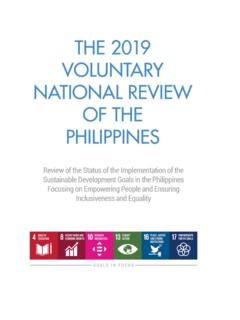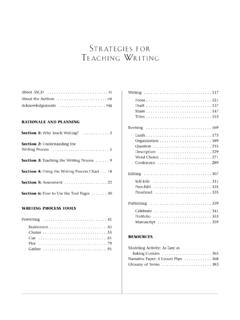Transcription of Chapter 1. What Is Backward Design? - Educational Technology
1 Understanding by Designby Grant Wiggins and Jay McTigheChapter 1. What Is Backward Design? To begin with the end in mind means to start with a clear understanding of your destination. It means to know where you're going so that you better understand where you are now so that the steps you take are always in the right direction. Stephen R. Covey, The Seven Habits of Highly Effective People design (vb) To have purposes and intentions; to plan and execute Oxford English DictionaryTeachers are designers. An essential act of our profession is the design of curriculum and learning experiences to meet specified purposes.
2 We are also designers of assessments to diagnose student needs to guide our teaching and to enable us, our students, and others (parents and administrators) to determine whether our goals have been achieved; that is, did the students learn and understand the desired knowledge?Like other design professions, such as architecture, engineering, or graphic arts, designers in education must be mindful of their audiences. Professionals in these fields are strongly client centered. The effectiveness of their designs corresponds to whether they have accomplished their goals for the end users. Clearly, students are our primary clients, given that the effectiveness of curriculum, assessment, and instructional designs is ultimately determined by their achievement of desired with other design professions, standards inform and shape our work.
3 The architect, for example, is guided by building codes, customer budget, and aesthetics. The teacher as designer is similarly constrained. We are not free to teach any topic we choose. Rather, we are guided by national, state, district, or institutional standards that specify what students should know and be able to do. These standards provide a framework to help us identify teaching and learning priorities and guide our design of curriculum and assessments. In addition to external standards, we also consider the needs of our students when designing learning experiences. For example, student interests, developmental levels, and previous achievements influence our the Best Curricular Designs " Backward "?
4 How, then, do these design considerations apply to curriculum planning? We use curriculum as a means to an end. We focus on a particular topic ( , racial prejudice), use a particular resource ( , To Kill a Mockingbird), and choose specific instructional methods ( , Socratic seminar to discuss the book and cooperative groups to analyze stereotypical images in films and on television) to cause learning to meet a given standard ( , the student will understand the nature of prejudice, and the difference between generalizations and stereotypes).Why do we describe the most effective curricular designs as " Backward "?
5 We do so because many teachers begin with textbooks, favored lessons, and time-honored activities rather than deriving those tools from targeted goals or standards. We are advocating the reverse: One starts with the end the desired results (goals or standards) and then derives the curriculum from the evidence of learning (performances) called for by the standard and the teaching needed to equip students to perform. This view is hardly radical. Ralph Tyler (1949) described the logic of Backward design clearly and succinctly about 50 years ago: Educational objectives become the criteria by which materials are selected, content is outlined, instructional procedures are developed, and tests and examinations are prepared.
6 The purpose of a statement of objectives is to indicate the kinds of changes in the student to be brought about so that instructional activities can be planned and developed in a way likely to attain these objectives (pp. 1, 45). Backward design may be thought of as purposeful task analysis: Given a task to be accomplished, how do we get there? Or one might call it planned coaching: What kinds of lessons and practices are needed to master key performances? The approach to curricular design we are advocating is logically forward and commonsensical but Backward in terms of conventional habits, whereby teachers typically think in terms of a series of activities (as in the apples unit presented in the Introduction) or how best to cover a topic (as in the world history vignette).
7 This Backward approach to curricular design also departs from another common practice: thinking about assessment as something we do at the end, once teaching is completed. Rather than creating assessments near the conclusion of a unit of study (or relying on the tests provided by textbook publishers, which may not completely or appropriately assess our standards), Backward design calls for us to operationalize our goals or standards in terms of assessment evidence as we begin to plan a unit or course. It reminds us to begin with the question, What would we accept as evidence that students have attained the desired understandings and proficiencies before proceeding to plan teaching and learning experiences?
8 Many teachers who have adopted this design approach report that the process of "thinking like an assessor" about evidence of learning not only helps them to clarify their goals but also results in a more sharply defined teaching and learning target, so that students perform better knowing their goal. Greater coherence among desired results, key performances, and teaching and learning experiences leads to better student performance the purpose of Backward design ProcessThe logic of Backward design suggests a planning sequence for curriculum. This sequence has three stages, shown in Figure In this section, we examine these stages and illustrate their application with an example of a design for a 5th grade unit on 1.
9 Identify Desired ResultsWhat should students know, understand, and be able to do? What is worthy of understanding? What enduring understandings are desired?In this first stage, we consider our goals, examine established content standards (national, state, and district), and review curriculum expectations. Given that there typically is more content than can reasonably be addressed, we are obliged to make choices. A useful framework for establishing curricular priorities may be depicted using the three nested rings shown in Figure empty background within the middle ring represents the field of possible content (topics, skills, and resources) that might be examined during the unit or course.
10 Clearly, we cannot address all areas; thus, the largest ring identifies knowledge that students should find worth being familiar with. During the unit or course, what do we want students to hear, read, view, research, or otherwise encounter? For example, in an introductory course on classroom assessment, it makes sense for adult students to be conversant with the history of standardized testing in the United States and in other nations. Broad-brush knowledge, assessed through traditional quiz or test questions, would be sufficient, given the purpose of the the middle ring, we sharpen our choices by specifying important knowledge (facts, concepts, and principles) and skills (processes, strategies, and methods).

